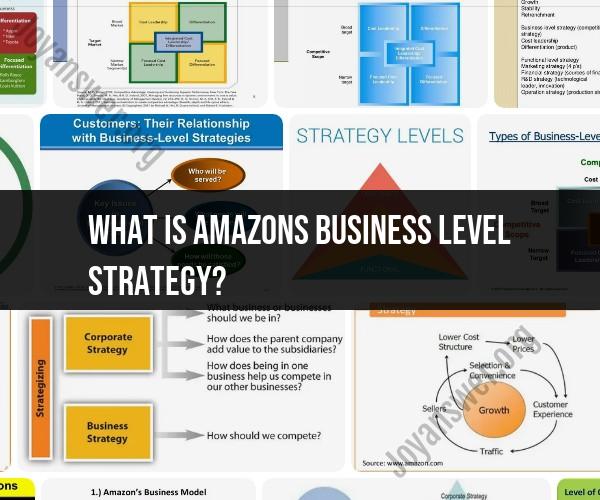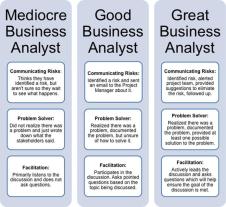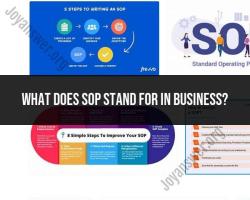What is Amazons business level strategy?
Amazon's business-level strategy is primarily focused on differentiation and cost leadership. This strategy aims to provide customers with a wide selection of products and services at competitive prices while also offering a unique and convenient shopping experience. Here's an overview and analysis of Amazon's business-level strategy:
Cost Leadership:
Efficiency and Scale: Amazon leverages its immense scale to achieve cost advantages in various aspects of its business, including procurement, distribution, and fulfillment. This allows the company to offer competitive prices to customers.
Investment in Technology: Amazon heavily invests in cutting-edge technology, such as robotics and automation, to optimize its operations and reduce costs. This technology also enhances its logistics and supply chain management.
Amazon Web Services (AWS): AWS, Amazon's cloud computing platform, not only provides significant revenue but also helps Amazon achieve cost leadership through economies of scale in data centers and infrastructure.
Third-Party Marketplace: Amazon allows third-party sellers to use its platform, which increases the product selection without the need for Amazon to own and store all inventory, further reducing costs.
Differentiation:
Customer-Centric Approach: Amazon focuses on delivering an exceptional customer experience by offering a wide range of products, fast and reliable shipping options (e.g., Amazon Prime), and excellent customer service.
Innovation and R&D: The company continually innovates in areas like artificial intelligence (e.g., Alexa), hardware (e.g., Kindle devices), and entertainment (e.g., Prime Video). These innovations enhance the differentiation of its product and service offerings.
Content Creation and Exclusive Deals: Amazon invests in creating original content for Prime Video and securing exclusive deals, differentiating its entertainment offerings from competitors.
Amazon Go and Physical Stores: Amazon has ventured into brick-and-mortar retail with concepts like Amazon Go stores and the acquisition of Whole Foods, offering differentiated shopping experiences.
Market Expansion and Diversification:
Amazon has expanded into various markets beyond its core e-commerce business, including cloud computing (AWS), digital streaming (Prime Video), smart devices (Echo), and healthcare (Amazon Pharmacy).
These diversifications allow Amazon to reduce risk by not relying solely on one market segment and capture more of consumers' time and spending.
Long-Term Orientation:
- Amazon has a reputation for focusing on long-term growth and customer satisfaction over short-term profits. This approach enables the company to invest in R&D, infrastructure, and market expansion without being solely driven by quarterly financial results.
Acquisitions and Partnerships:
- Amazon strategically acquires companies (e.g., Whole Foods, Zappos) and forms partnerships to expand its product and service offerings and strengthen its competitive position.
In summary, Amazon's business-level strategy combines cost leadership with differentiation to provide customers with a wide array of products and services, competitive prices, and a superior shopping experience. This strategy has enabled Amazon to dominate the e-commerce market and diversify into various other industries while maintaining a customer-centric focus and long-term orientation.
Amazon's Business-Level Strategy: An In-Depth Analysis
Amazon's business-level strategy is focused on providing a wide selection of products and services at competitive prices, with convenient delivery options. Amazon also emphasizes customer satisfaction and innovation.
Amazon's business-level strategy is based on the following key elements:
- Customer obsession: Amazon is known for its customer-centric culture. The company puts the customer first in everything it does, from product development to customer service.
- Wide selection: Amazon offers a wide selection of products, from books and electronics to groceries and furniture. This allows Amazon to meet the needs of a wide range of customers.
- Competitive prices: Amazon offers competitive prices on its products and services. This is due in part to the company's efficient supply chain and its focus on economies of scale.
- Convenient delivery options: Amazon offers a variety of convenient delivery options, including free two-day shipping for Prime members. This makes it easy for customers to get the products they need quickly and easily.
- Innovation: Amazon is constantly innovating and developing new products and services. This allows the company to stay ahead of the competition and meet the changing needs of its customers.
Amazon's business-level strategy has been very successful. The company has grown rapidly in recent years and has become one of the most valuable companies in the world.
Unpacking Amazon's Competitive Strategy
Amazon's competitive strategy is based on the following key elements:
- Cost leadership: Amazon is a low-cost producer. It is able to achieve this through its efficient supply chain and its focus on economies of scale.
- Differentiation: Amazon differentiates itself from its competitors by offering a wide selection of products, competitive prices, convenient delivery options, and a focus on customer satisfaction.
- Focus: Amazon is focused on a few key businesses: e-commerce, cloud computing, and digital media. This allows the company to focus its resources and develop expertise in these areas.
Amazon's competitive strategy has been very effective. The company has been able to undercut its competitors on price and offer a better customer experience. As a result, Amazon has become the dominant player in the e-commerce market.
Strategic Positioning: Understanding Amazon's Business-Level Approach
Amazon's business-level approach is based on the following strategic positioning elements:
- Broad target market: Amazon targets a broad range of customers, from individuals to businesses to governments. This allows the company to reach a large customer base and maximize its sales potential.
- Undifferentiated products: Amazon sells a wide range of products, many of which are undifferentiated. This means that customers are not always brand-loyal and may be willing to switch to a different retailer if they can find a better price or delivery option.
- Low prices: Amazon offers low prices on its products and services. This is due in part to the company's efficient supply chain and its focus on economies of scale.
- Convenient delivery options: Amazon offers a variety of convenient delivery options, including free two-day shipping for Prime members. This makes it easy for customers to get the products they need quickly and easily.
Amazon's business-level approach has been very successful. The company has grown rapidly in recent years and has become one of the most valuable companies in the world.
Overall, Amazon's business-level strategy is focused on providing a wide selection of products and services at competitive prices, with convenient delivery options. Amazon also emphasizes customer satisfaction and innovation. This strategy has been very successful and has made Amazon one of the most dominant companies in the world.













